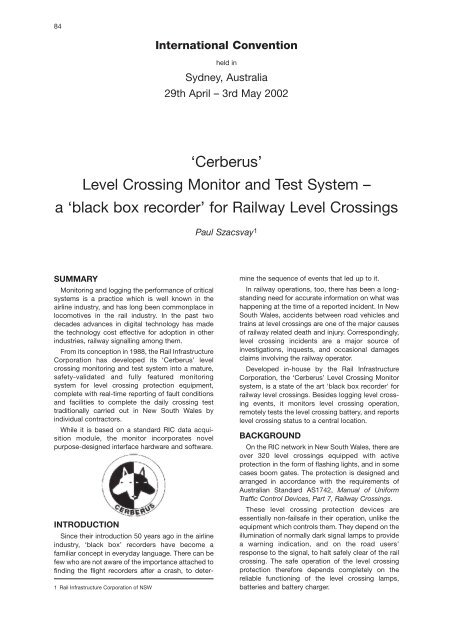Proceedings 2002/2003 - IRSE
Proceedings 2002/2003 - IRSE
Proceedings 2002/2003 - IRSE
Create successful ePaper yourself
Turn your PDF publications into a flip-book with our unique Google optimized e-Paper software.
84<br />
International Convention<br />
held in<br />
Sydney, Australia<br />
29th April – 3rd May <strong>2002</strong><br />
‘Cerberus’<br />
Level Crossing Monitor and Test System –<br />
a ‘black box recorder’ for Railway Level Crossings<br />
Paul Szacsvay 1<br />
SUMMARY<br />
Monitoring and logging the performance of critical<br />
systems is a practice which is well known in the<br />
airline industry, and has long been commonplace in<br />
locomotives in the rail industry. In the past two<br />
decades advances in digital technology has made<br />
the technology cost effective for adoption in other<br />
industries, railway signalling among them.<br />
From its conception in 1988, the Rail Infrastructure<br />
Corporation has developed its ‘Cerberus’ level<br />
crossing monitoring and test system into a mature,<br />
safety-validated and fully featured monitoring<br />
system for level crossing protection equipment,<br />
complete with real-time reporting of fault conditions<br />
and facilities to complete the daily crossing test<br />
traditionally carried out in New South Wales by<br />
individual contractors.<br />
While it is based on a standard RIC data acquisition<br />
module, the monitor incorporates novel<br />
purpose-designed interface hardware and software.<br />
INTRODUCTION<br />
Since their introduction 50 years ago in the airline<br />
industry, ‘black box’ recorders have become a<br />
familiar concept in everyday language. There can be<br />
few who are not aware of the importance attached to<br />
finding the flight recorders after a crash, to deter-<br />
1 Rail Infrastructure Corporation of NSW<br />
mine the sequence of events that led up to it.<br />
In railway operations, too, there has been a longstanding<br />
need for accurate information on what was<br />
happening at the time of a reported incident. In New<br />
South Wales, accidents between road vehicles and<br />
trains at level crossings are one of the major causes<br />
of railway related death and injury. Correspondingly,<br />
level crossing incidents are a major source of<br />
investigations, inquests, and occasional damages<br />
claims involving the railway operator.<br />
Developed in-house by the Rail Infrastructure<br />
Corporation, the ‘Cerberus’ Level Crossing Monitor<br />
system, is a state of the art 'black box recorder' for<br />
railway level crossings. Besides logging level crossing<br />
events, it monitors level crossing operation,<br />
remotely tests the level crossing battery, and reports<br />
level crossing status to a central location.<br />
BACKGROUND<br />
On the RIC network in New South Wales, there are<br />
over 320 level crossings equipped with active<br />
protection in the form of flashing lights, and in some<br />
cases boom gates. The protection is designed and<br />
arranged in accordance with the requirements of<br />
Australian Standard AS1742, Manual of Uniform<br />
Traffic Control Devices, Part 7, Railway Crossings.<br />
These level crossing protection devices are<br />
essentially non-failsafe in their operation, unlike the<br />
equipment which controls them. They depend on the<br />
illumination of normally dark signal lamps to provide<br />
a warning indication, and on the road users'<br />
response to the signal, to halt safely clear of the rail<br />
crossing. The safe operation of the level crossing<br />
protection therefore depends completely on the<br />
reliable functioning of the level crossing lamps,<br />
batteries and battery charger.

















